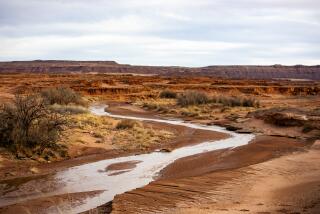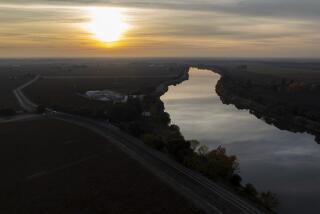Is this Mojave water project worth the risk?
The search for reliable water supplies for Southern California has been going on for as long as Americans have lived here, and continues today. State officials are examining a proposal to draw water from the Sacramento River and ship it to this part of California, bypassing the Sacramento-San Joaquin River Delta and its shaky levees. Los Angeles officials are also trying to balance the water needs of the city against their obligations to hold down dust in the Owens Valley, which has long supplied much of Los Angeles’ water and whose brackish lake dried up in the process. The debates over water often are complicated and weighted by competing and compelling interests.
But all water projects are not the same, and one that deserves special scrutiny is a recent proposal to draw thousands of acre-feet of water out of an aquifer that sits beneath the Mojave Desert and send it to users throughout the region, especially the Santa Margarita Water District, which supplies part of Orange County. The water district last week gave the project a boost by approving its environmental impact report.
That’s the latest step in a long march. The project has been pursued for more than a decade by Keith Brackpool, an influential Southern California businessman (Mayor Antonio Villaraigosa once worked for Brackpool, who also served as a key water advisor to Gov. Gray Davis). If approved, it would clear the way for Brackpool and his company,Cadiz Inc., to sell enough water every year to serve 100,000 homes. Cadiz could make $1 billion to $2 billion over the 50-year span of the deal.
Some may flinch at the philosophical implications of a private investor selling water that accumulated for centuries beneath his land to public agencies for his own profit. But for better or worse, that bridge was long ago crossed. The farmers of the Owens Valley, for instance, sold their water rights to representatives of Los Angeles in the early 20th century, and that water continues to provide this city with much of its supply.
What makes the Cadiz project unique are two factors: its size and its location. Selling 50,000 to 75,000 acre-feet of water a year, as the company proposes to do, is an extraordinary exchange of water. It would require the construction of a 43-mile pipeline, and it would pump more water out of the ground than any previous private project in California. More important, the water would be drawn from the ancient aquifer that has undergirded the Mojave Desert from time immemorial. No one knows precisely how quickly that aquifer replenishes. If the Cadiz project draws water faster than rain and snow can refill it, the aquifer will dry up — and the desert will die.
Will that happen? Cadiz’s experts say no, that the aquifer can sustain the anticipated withdrawals and replenish annually. But other experts take a far more conservative view of how much water can safely be drawn from the aquifer. The gap between Cadiz’s estimates of the replenishment rate and those of the government is staggering and of great consequence: The Cadiz estimates are three to 16 times higher than those of the U.S. Geological Surveyand other experts, according to the National Park Service. If the USGS is right and Cadiz is wrong, the project would rapidly destroy the aquifer.
Recognizing the potentially grave implications for the Mojave, Sen. Dianne Feinstein (D-Calif.) wrote this year to Interior Secretary Ken Salazar to urge his department to perform an assessment of the project’s likely impact on the ecology of the region. That’s a prudent proposal. Salazar should heed it.
Yes, federal intervention could slow this deal, which Rancho Santa Margarita and Cadiz understandably are eager to get underway. But the range of the estimates in play here — and the clear interest that Cadiz and Rancho Santa Margarita have in accepting best-case scenarios — suggest that an objective agency with a broader perspective should conduct its own analysis.
It may be that Cadiz’s estimates will stand up to scrutiny; if so, this deal could provide precious water to areas that need it. Before it’s allowed to go forward, however, neutral experts need to give it their best appraisal.
More to Read
A cure for the common opinion
Get thought-provoking perspectives with our weekly newsletter.
You may occasionally receive promotional content from the Los Angeles Times.










